|
DAP CE8640B
A time and battle-tested platform
(by Conrad H. Blickenstorfer -- view review as PDF)
Update 12/13/2010: The DAP CE8640B is now named M8640, bringing it in line with DAP's "Mxxxx" nomenclature for its lineup of handheld computers
In this day and age of UMPCs and tiny little Windows machines that run Vista and all, a device like the CE8640B by DAP Technologies is a rare breed indeed. It may look like a ruggedized UMPC, but it's not. The DNA of this machine stems from another era though it is technologically as up-to-date as it can be. It is a super-rugged Windows CE 5.0-powered handheld PC merging a 640 x 240 half-VGA touchscreen and a compact QWERTY keyboard into a handy and eminently useful package for a wide range of field-based applications where small size, total reliability, near endless battery life, and invincible toughness matter.

The CE8640B
The 8640 model is one of two branches of DAP's CE8000 family of rugged handhelds. Just as the company is giving customers the choice of selecting a portrait or a landscape oriented display in their CE5000 Series, they provide a choice of pure tablet (the 8800) or, as is the case with the 8640, a tablet that splits the real estate between a half-VGA display and an integrated keyboard.
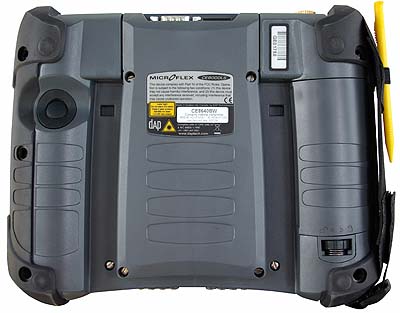 The overall design has also been called an "open notebook" because it looks like a small handheld notebook computer that's been opened. There is no screen hinge here, however, as the 8640 is a tablet. It's fairly compact with a footprint of about 9 x 7 inches. Its thickness varies between an inch-and-a-half and two inches, and it weighs about 2.5 pounds with the battery installed. The overall design has also been called an "open notebook" because it looks like a small handheld notebook computer that's been opened. There is no screen hinge here, however, as the 8640 is a tablet. It's fairly compact with a footprint of about 9 x 7 inches. Its thickness varies between an inch-and-a-half and two inches, and it weighs about 2.5 pounds with the battery installed.
This is actually an interesting design solution that was also explored by Husky in several ruggedized Windows and Windows CE designs. That company was later bought out by Itronix, which is now General Dynamics Itronix.
While some tablets are a bit awkward to hold, that is not the case with the 8640. It has a very ergonomic design and is easy to hold and operate. If you look at the unit's backside shown in the image to the right, you can see bulges on the left and right side of the unit, and deep grooves inside of them. This way, you can comfortably hold the computer with both hands or with either the left or the right.
The centerpart inbetween is what makes the 8640 so versatile. Underneath the thick plastic cover is an expansion bay that can accommodate a variety of options. Our review unit contained a PC Card Type II slot and a SDIO Card slot.  There is plenty of space in front of the PC Card slot so that it can handle extended cards. There is also an additional connector for other integrated peripherals. The cap itself can include different interfaces or house custom-built peripheral options. Ours had a USB host connector and a 9-pin serial plug. The cap is secured down with four screws and is totally waterproof thanks to a rubber O-ring seal. There is plenty of space in front of the PC Card slot so that it can handle extended cards. There is also an additional connector for other integrated peripherals. The cap itself can include different interfaces or house custom-built peripheral options. Ours had a USB host connector and a 9-pin serial plug. The cap is secured down with four screws and is totally waterproof thanks to a rubber O-ring seal.
The two bulges mentioned above also do more than just provide a good grip for you hands.
One of them houses the 17.8 watt-hour (7.4Volt/2,400mAH) rechargeable Lithium-Ion battery pack that, according to DAP, is good for as much as four working days under depending upon operating conditions. That's pretty phenomenal. To remove or replace it, you turn a spring-loaded thumbwheel until the battery pack is released. With this kind of battery life, take a spare with you and you never have to worry about finding an outlet.
The other side can contain either an integrated 1D and 2D CMOS imager or a 1D laser scanner. A rubberized trigger button sits in an ergonomically molded indent so you cannot miss it.
Below you can see the front of the very sturdily built 8640 and all of its sides. As if the super-tough ABS plastic body were not rugged enough, the device also has thick rubber bumpers on both the left and right sides. They cover all eight corners, making the unit virtually invulnerable.
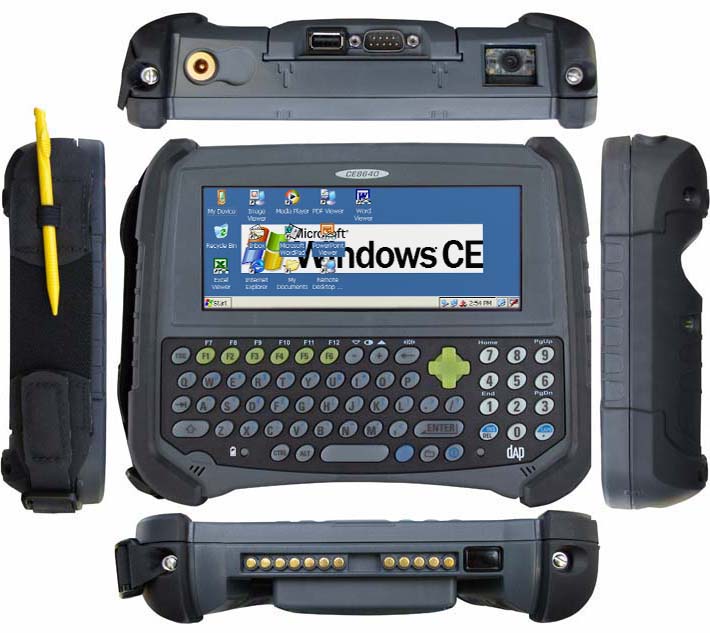
The left side has a carry strap that also has an elastic loop to stow away the bright-yellow plastic stylus when it is not needed. The strap can be attached to either the left or the right side.
The top of the unit shows the power jack on one side and the scanner window on the other. Our unit came with serial and USB ports; other port arrangements can be ordered as well.
The bottom shows the surface-mount charging/dock connectors. Surface-mount connectors are more reliable and last much longer than pin-based connectors. To the right of the contact banks is an infrared window.
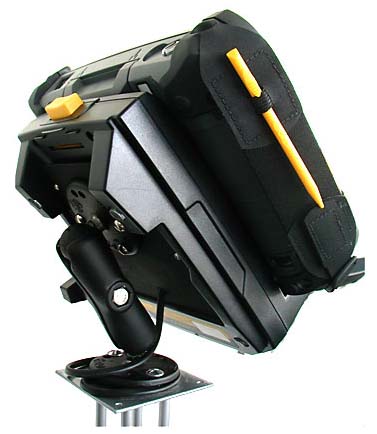 Below the screen, the 8640 has an integrated 61-key keyboard with separate numeric keypad. The alpha keys are arranged in the standard QWERTY layout. It is a 64%-scale arrangement -- small, but not too small to type. The oval keys are labeled black on gray, white or light-green backgrounds. They are easy to read and illuminated in the dark. The keyboard is full-featured, with F1 through F12 function keys and pretty much everything else you'd expect in a full keyboard. The keys provide both tactile and sound feedback (sound can be disabled). You need to press them fairly hard to register, and, as is the case on most most keyboards of this kind, they feel a bit wobbly. Below the screen, the 8640 has an integrated 61-key keyboard with separate numeric keypad. The alpha keys are arranged in the standard QWERTY layout. It is a 64%-scale arrangement -- small, but not too small to type. The oval keys are labeled black on gray, white or light-green backgrounds. They are easy to read and illuminated in the dark. The keyboard is full-featured, with F1 through F12 function keys and pretty much everything else you'd expect in a full keyboard. The keys provide both tactile and sound feedback (sound can be disabled). You need to press them fairly hard to register, and, as is the case on most most keyboards of this kind, they feel a bit wobbly.
How do you use the keyboard? From the looks of it you might think using the unit like a BlackBerry in thumbtype mode works best. That's the case to some extent, but the unit is too wide for the right thumb to comfortably reach the QWERTY keys. What that means is that, like with all mobile and handheld computers, every user will develop his or her own style.
Docks and mounting solutions are crucial for computers that are used in the field. You need to be able to easily insert a unit into its dock or cradle, and easily remove it from the dock. The dock should provide extra functionality and you should be able to mount it anywhere. DAP Technologies delivers with a variety of cradles. An office cradle can be had with a serial RS232 port and either USB or Ethernet. There are vehicle cradles that include either a single serial port or four of them. There is a lock option for vehicle use, and a wall adapter for the office cradle. Those who use the 8640 in a vehicle can get the articulated RAM-Mount support solution (see image to the right). It's the industry standard and unsurpassed in flexibility and simplicity of use.
Display -- UltiVue to the rescue
The 8640's half-VGA display was quite common in the heydays of the Microsoft Handheld PC platform. With 640 x 240 pixels it is wide enough to view documents, spreadsheets, presentations and web pages. 240 pixels isn't very tall, but the idea is that you can quickly scroll, and the wide format made small, elegant clamshell handhelds possible. Used in a device like the 8640, the wide screen allows both the display and the keyboard fit onto the surface of a handy tablet.
There are some caveats. LCD manufacturers always focus on whatever's hot and in demand. The iPhone screen, for example, is so sleek and terrific because Apple needs millions of them and that pays for perfecting and then amortizing the latest technology. The 6.5-inch 640 x 240 pixel format, on the other hand, hasn't been much in demand for a decade, and even then it was a low volume product. As a result, the one used in the 8640 is far from state-of-the-art. It is transflective, which is good as that provides outdoor readability, but it uses older passive STN (super-twisted nematic) technology. STN is much slower than what we're used to in modern screens. There are also color shifts as you vary the vertical viewing angle. There was really not much DAP could do to improve the situation and still stay with the interesting "open book" design.
They did, however, come up with an improvement called "UltiVue." It's not a new display, but a new touch membrane with less reflection, polarized coating and the use of a compound between the LCD and the touch membrane. Those treatments combine to provide easier reading in all light conditions and especially in direct, bright sunlight. Since outdoor readability depends on effective contrast as well as backlight, better effective contrast, which UltiVue provides, means you can dial down the backlight or, in sunlight, turn it off entirely. This extends the 8640's already spectacular battery life.
Updated technology
While the display, with the exception of the clever UltiVue screen treatment, dates back to earlier times, the rest of the CE8640B is technologically quite up-to-date. It's powered by a speedy 520MHz version of the Marvell PXA270 XScale processor, a far cry from the chips in the old H/PCs. The 8640 also supports interface and communications technologies unknown in the early days of Windows CE. In addition to USB and legacy RS-232 and IR ports, our unit came with integrated Bluetooth and 802.11b/g Wi-Fi.
Internal memory consisted of 128MB of SRAM (about half of which was used by the OS), and 256MB of Flash (about 192MB available to users). Pop in a SD card and -- bingo -- gigabytes of storage. To see if larger format cards worked I inserted a 2GB SanDisk card. The 8640 immediately saw the card and loaded the 10-megapixel pictures on it without any problems.
Between the fast processor, the generous amount of memory, and fast WiFi, the 8640 could easily do things that would have never been possible in the original H/PC days. The unit never slowed down, it easily ran even complex websites with Flash, and it quickly loaded large files. Even scrolling 10-megapixel files posed no problem at all.
Software
Between the uncommon 640 x 240 pixel display format and an embedded operating system like Windows CE 5.0, the user experience is very different from working on a standard Windows computer or even a Pocket PC. By different I mean it requires getting used to, and it requires software formatted for the 640 x 240 display. A lot of 8640 units will likely be deployed with special custom software installed, and so the screen format is not an issue as the applications are designed for it.
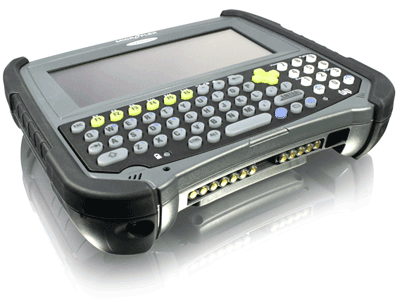 For those not familiar with Windows CE, here's a brief overview: Since Windows CE is an embedded OS, it contains only a small subset of all the functions and functionality of a full OS. The idea is to include exactly what a user needs, as opposed to the everything-and-the-kitchen-sink approach of a full desktop OS like Vista. Microsoft makes certain application programs available for Windows CE, and those include limited versions of most of the familiar Office apps. The 8640, for example, comes with a Word viewer, an Excel viewer, a PowerPoint viewer, and a PDF viewer. "Viewer" means just that; you can load and view Word, Excel, PowerPoint and PDF files, but you cannot create or change them. For actually creating documents you use Microsoft WordPad. There are Windows CE versions of most Office apps that allow creating and editing of files, but they are not installed. There are, however, a capable image viewer, the Microsoft Media Player (9 Series), Internet Explorer for browsing, and an email application. You can also chat with MSN Messenger. For those not familiar with Windows CE, here's a brief overview: Since Windows CE is an embedded OS, it contains only a small subset of all the functions and functionality of a full OS. The idea is to include exactly what a user needs, as opposed to the everything-and-the-kitchen-sink approach of a full desktop OS like Vista. Microsoft makes certain application programs available for Windows CE, and those include limited versions of most of the familiar Office apps. The 8640, for example, comes with a Word viewer, an Excel viewer, a PowerPoint viewer, and a PDF viewer. "Viewer" means just that; you can load and view Word, Excel, PowerPoint and PDF files, but you cannot create or change them. For actually creating documents you use Microsoft WordPad. There are Windows CE versions of most Office apps that allow creating and editing of files, but they are not installed. There are, however, a capable image viewer, the Microsoft Media Player (9 Series), Internet Explorer for browsing, and an email application. You can also chat with MSN Messenger.
DAP includes a number of additional programs like the CE Pad editor, a wave file recorder, a FTP server, etc. To get an idea of the real power of the system you need to look at the settings and control panels. Our test unit had over 30 of them. Many are the exact equivalent of panels you find in Windows XP whereas others are specific to Windows CE. There are also device-specific panels such as one that handles the integrated scanner or several that deal with connectivity, communications and security. In some areas the OS shows its mid-1990's origin as in numerous references to modems and dial-up, and some of the utilities and panels get pretty technical.
PC connectivity
Unlike today's smartphones and handhelds, Windows CE devices were not originally conceived as PDAs or independent units. Instead, Microsoft viewed them as "PC companions," little machines that worked in conjunction with a desktop computer. As a result, much emphasis was placed on synchronizing data between the CE device and the desktop. Connection was usually via serial cable or cradle, and later via USB. Some users preferred infrared as a means of communication, and that option remains available. The synchronization process required Microsoft's ActiveSync, an application that not only synchronized, but also sort of mounted the CE device so you could peruse its directories from the desktop PC, or dragging files back and forth. Originally, almost all files dragged to a Windows CE device needed conversion from the desktop to the mobile format, and ActiveSync performed that task. Likewise, almost all applications had to be installed on the PC and ActiveSync then installed them on the CE device upon synchronization. That's the case even today. I was, for example, trying to install an old screen grabber so I could illustrate this review with screen shots instead of relying on photography where the screen doesn't look nearly as good as it looks to the eye. Unfortunately, even though you can easily download apps from the web, you cannot install them from the CE device directly, and I didn't have the proper cable to connect to a PC. That's both good and bad. It can certainly be a drag, but it also makes for a much more secure and controllable environment, and that's a good thing for devices that are tools for the job.
There was a time when the primary challenge was providing connectivity. Today there is often almost too much connectivity, and the primary challenge is keeping the bad guys out of our machines. The 8640 offers very good security though that also requires observing common sense rules. You can, for example, use ftp to transfer files instead of ActiveSync. You can also do remote desktop connection or use terminal emulation programs. ActiveSync can be used via network connection. That requires downloading a server app to establish an Ethernet partnership. Note, however, that while the very good manual suggests using ActiveSync 3.8 or higher, it also states that an Ethernet partnership is only possible with 3.8 or lower -- a Microsoft constraint. Bottom line is that the 8640 connects just fine in almost any setting.
Ruggedness
In terms of ruggedness, 8640 users are covered. Anytime, anywhere. That's because the CE8640B is about as tough as they come. Consider this:
You can operate this machine within a temperature range of -4 to 122 degrees. That means anywhere from deserts to meat lockers. Temperature should never be an issue.
The 8640 carries an IP67 ingress protection rating. The "6" means it is completely sealed against dust. The "7" means it is protected against immersion into water. Yes, the 8640 is designed to withstand being in as much as 3.3 feet of water for up to an hour.
As far as being dropped goes, DAP felt the testing procedures described in MIL-STD-810F were not realistic enough as the military standard does not specify testing temperatures. So DAP not only dropped the 8640 26 times from four feet onto every face and corner, they did that entire test at -4 degrees Fahrenheit, at ambient temperature, and also at a blistering 122 degrees.
Looking at the unit, I am not sure what could possibly go wrong. The big rubber bumpers protect all sides and corners. The tough plastic will never break and probably doesn't even scratch. Displays always seem the most vulnerable part, but this one's scratch and shock resistant.
The RMT DAP CE8640B: bottom line
Like all RMT DAP units, the CE8640B is an uncompromising productivity tool for jobs out there. It is a somewhat unique solution that combines a full QWERTY keyboard and a half-VGA display on the surface of one compact tablet. That means you get twice the screen real estate available on a typical quarter-VGA terminal or PDA, but it comes in an uncommon format that requires getting used to. However, the large keyboard with its separate numeric keypad allows for rapid data entry. Combined with the available 1D laser scanner or 1D/2D imager, the 8640 can be a highly efficient data capture and processing unit for any number of field applications.
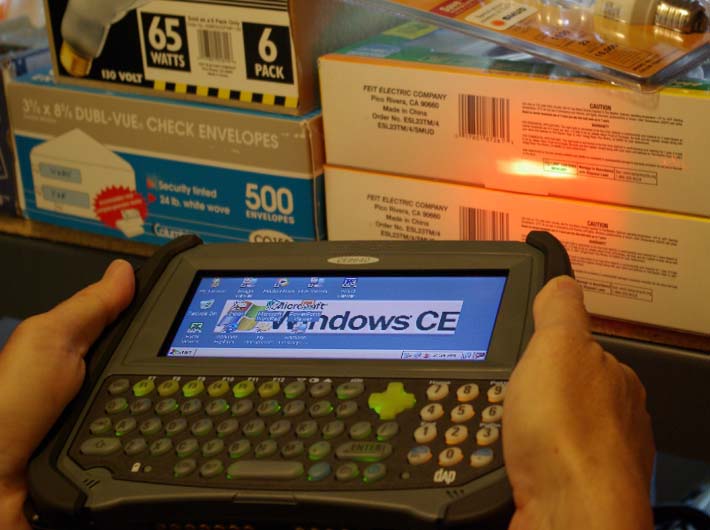
Ergonomically designed, the compact 2.5-pound device easily fits into hands. The display uses older STN technology and at times redraws slowly, but DAP's "UltiVue" technology provides excellent outdoor viewability even in direct sunlight. Under the hood, the 8640 uses up-to-date technology, including a speedy Marvell processor, Bluetooth, 802.11b/g Wi-Fi and an SDIO card slot. The unit is highly configurable via different expansion bay modules and caps. Battery life is spectacular.
The DAP Technologies 8640 is built on Windows CE 5.0, a very mature embedded operating system platform that can be customized, via readily available standard Microsoft software tools, for just about any purpose and application.
As far as ruggedness goes, the unit is so tough that there are never any concerns whether it will hold up. It truly can be operated anywhere and anyplace.
-- Conrad H. Blickenstorfer
DAP 8640 Specs:
| Type |
Rugged Handheld PC
|
| Processor |
520MHz Marvell PXA270 XScale |
| OS |
Windows CE 5.0
|
| Memory RAM/Storage Flash |
128MB/256MB |
| Display |
6.5-inch 640 x 240 pixel STN transflective color LCD with backlight |
| Digitizer |
touch screen |
| Keyboard |
Integrated 61-key QWERTY, 64%-scale |
| Expansion slots |
1 PC Card Type II, 1 SD/SDIO
|
| Housing |
Plastic |
| Size (inches) |
9.1 x 7.3 x 2.0 |
| Weight |
2.4 lbs.
|
| Operating temperature |
-4 to 122 degrees Fahrenheit |
| Ingress protection |
IP67 (totally dustproof; waterproof to 3.3 feet immersion for an hour) |
| Drop |
4-foot drop per MIL-STD-810F at extreme temperatures |
| Power |
Rechargeable Li-Ion 7.4V, 2,400mAH, 17.8 watt-hours ("2 to 4 working days") |
| Interface |
RS232, USB, IR, RJ45 (depends on configuration) |
| Wireless options |
Wireless edition includes Bluetooth Class 2 and 802.11b/g WiFi
|
| Price |
Starting at U$3,200 |
| Contact |
RMT DAP website |
(copyright 2008 RuggedPCReview.com)
|



